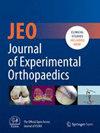Axial rotation of the hinge axis can cause changes in coronal tibial alignment in anterior tibial closing wedge osteotomy in a 3D simulation model
Abstract
Purpose
Clinical evidence indicates that an unintended increase in the medial proximal tibial angle (MPTA) can occur during slope-reducing tibial osteotomies, which is most relevant in anterior cruciate ligament (ACL) deficient knees. Therefore, the purpose of this three-dimensional (3D) simulation study is to assess how axial or coronal hinge axis rotation affect alignment parameters in anterior tibial closing wedge osteotomies (ACWO). The hypothesis states that a neutral hinge axis (NHA) in ACWO prevents changes in coronal and axial alignment.
Methods
A 3D surgical simulation was used to perform ACWO with a stepwise increment of one-degree (1°–5°) rotation around thirteen different hinge axes. Surface models were created from CT scans of 49 individuals (mean PTS 11.5° ± 3.8°) resulting in 3185 simulations. A NHA not changing the coronal or axial alignment was defined as oriented parallel to the posterior tibial plateau 1 cm underneath the articular surface. Anatomical landmarks were determined for each simulation to measure the PTS, MPTA, hip-knee-ankle angle (HKA), and tibial torsion (TT). The effects of the initial MPTA or PTS on the resulting alignment parameters and the effects of axial and sagittal rotation of the joint axis were analysed for their effects on postsimulation PTS, MPTA and TT.
Results
Clinically relevant hinge axis rotation in the coronal or axial plane below 20° did not significantly influence PTS correction (p > 0.05). Axial rotation of the hinge axis exceeding 10° led to significant MPTA changes (> +1.7° ± 0.03°) compared to the NHA (p < 0.001). Pre-simulation MPTA had no influence on post-simulation MPTA changes (p > 0.05).
Conclusion
NHA aligned parallel to the posterior tibial plateau below the articular surface prevents significant changes in MPTA during ATCWO. This 3D simulation suggest, that hinge axis orientation requires meticulous consideration during slope-reducing osteotomies to preserve alignment integrity.
Level of Evidence
Level V, retrospective simulation study.


 求助内容:
求助内容: 应助结果提醒方式:
应助结果提醒方式:


